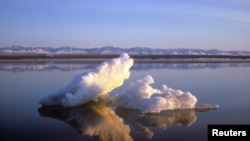The thickness of Arctic sea ice continues to decline, according to the European Space Agency (ESA)
The conclusion is based on three consecutive years of measurements by ESA’s CryoSat satellite mission. Scientists often measure another factor, sea-ice extent, but ice thickness, the agency says, is a “more accurate” measure of the changes taking place at the top of the world.
Professor Andrew Shephers of the University of Leeds in England told an audience at the Living Planet Symposium in Edinburgh, Scotland Wednesday that CryoSat “continues to provide clear evidence of diminishing Arctic sea ice.”
“From the satellite’s measurements, we can see that some parts of the ice pack ice have thinned more rapidly than others, but there has been a decrease in the volume of winter and summer ice over the past three years”, he said. “The volume of the sea ice at the end of last winter was less than 15,000 cubic kilometers, which is lower than any other year going into summer and indicates less winter growth than usual.”
While it seems unlikely that a record minimum of sea-ice extent will be set this September, the thinner ice at the start of summer could mean that the actual volume of ice may reach a new low, according to ESA.
“Readings from CryoSat in October, when the ice starts to refreeze, will confirm this either way,” said Rachel Tilling, doctoral student at University College London, who is working with the CryoSat data.
CryoSat is also delivering important results on land ice formation. Recently, it provided evidence of a huge flood under the Antarctic ice sheet. New measurements combined with older data from NASA’s ICESat mapped a large crater that formed as the overlying ice sank to fill the gap left by lake water that drained away.
The map revealed that about six cubic kilometers of water had escaped from under the ice, probably straight into the ocean, between 2007 and 2008.
CryoSat is expected to continue providing data until 2017.
Watch an animation showing the variations in ice thickness over time:
The conclusion is based on three consecutive years of measurements by ESA’s CryoSat satellite mission. Scientists often measure another factor, sea-ice extent, but ice thickness, the agency says, is a “more accurate” measure of the changes taking place at the top of the world.
Professor Andrew Shephers of the University of Leeds in England told an audience at the Living Planet Symposium in Edinburgh, Scotland Wednesday that CryoSat “continues to provide clear evidence of diminishing Arctic sea ice.”
“From the satellite’s measurements, we can see that some parts of the ice pack ice have thinned more rapidly than others, but there has been a decrease in the volume of winter and summer ice over the past three years”, he said. “The volume of the sea ice at the end of last winter was less than 15,000 cubic kilometers, which is lower than any other year going into summer and indicates less winter growth than usual.”
While it seems unlikely that a record minimum of sea-ice extent will be set this September, the thinner ice at the start of summer could mean that the actual volume of ice may reach a new low, according to ESA.
“Readings from CryoSat in October, when the ice starts to refreeze, will confirm this either way,” said Rachel Tilling, doctoral student at University College London, who is working with the CryoSat data.
CryoSat is also delivering important results on land ice formation. Recently, it provided evidence of a huge flood under the Antarctic ice sheet. New measurements combined with older data from NASA’s ICESat mapped a large crater that formed as the overlying ice sank to fill the gap left by lake water that drained away.
The map revealed that about six cubic kilometers of water had escaped from under the ice, probably straight into the ocean, between 2007 and 2008.
CryoSat is expected to continue providing data until 2017.
Watch an animation showing the variations in ice thickness over time:












